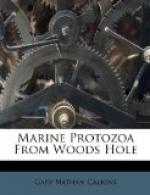This species is much smaller than the preceding, and might easily be mistaken for Uronema marina. It is subcylindrical in form, the anterior end bluntly pointed, the posterior end rounded. The oral apparatus is quite different from Uronema. The mouth, as in the preceding species, is at the end of a long peristomial groove extending from the anterior end to the middle of the body. The edges of the peristome bear undulating membranes as in L. infusionum. Like the latter, there is one caudal bristle, but unlike it there is only one posterior contractile vacuole, while the endoplasm is filled with large granules or food balls. The cuticle is distinctly striated with longitudinal markings, and the cilia are uniform in length.
Habitat similar to that of L. infusionum, in
zoogloea masses.
Length 26 to 30 mu; diameter 7 to 8 mu.
Although Quennerstedt’s description of L. pusillus makes no mention of a caudal bristle, the size and other characters are so closely similar that I hesitate to make a new species. The bristle is extremely delicate, scarcely thicker than a cilium, and easily overlooked, yet with proper focussing of the condenser I found it on every specimen examined.
[Illustration: Fig. 43.—Lembus pusillus.]
KEY TO MARINE GENERA OF OPALINIDAE.
Diagnostic characters: The form is oval, and the body may be short or drawn out to resemble a worm. They are characterized mainly by the absence of mouth and pharynx.
Anterior end not pointed; body Genus *_Anoplophrya_ cylindrical; tapering
Anterior end pointed; body elongate; Genus Opalinopsis cylindrical; tapering
* Presence at Woods Hole indicated by asterisk.
Genus ANOPLOPHRYA Stein ’60.
(Stein ’60; Claparede ’60; Leidy ’77;
Vejdovsky ’79; Kent ’81;
Balbiani ’85; Buetschli ’88; Shevyakov
’96.)
The general form is elongate, cylindrical or slightly flattened, with rounded ends, the posterior end tapering. The body is striated with clearly defined, often depressed lines, which run longitudinally and sometimes spirally. The contractile vacuoles are usually placed in rows upon the edges. The macronucleus is almost always long and band-formed, rarely oval, and generally extending through the entire length of the body. Micronuclei have been made out in one case. Reproduction is effected by simple cross division or by budding at the posterior end, and is frequently combined with chain formation. The main characteristic is the entire absence of mouth and oesophagus, the animals being parasitic in the digestive tract of various annelids. Parasites, salt-water forms.
Anoplophrya branchiarum. Stein ’52. Fig. 44.
A. circulans Balbiani.




